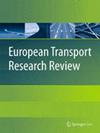Pedestrian gaze pattern before crossing road in a naturalistic traffic setting
IF 4.2
3区 工程技术
引用次数: 0
Abstract
Abstract Background Gaze is the primary way for pedestrians to obtain clues from traffic scenes before making decisions. Therefore, understanding pedestrian gaze pattern is vital for traffic safety in general and for the design of autonomous vehicles. Methods In this study, participants made road-crossing decisions in a naturalistic traffic scene, with an eye-tracker recording their gaze behaviors. We manually encoded the recorded videos with 14,898 fixations, and then analyzed the gaze pattern at three levels from general to specific: gaze towards overall scenes, gaze towards vehicles and gaze towards components of vehicles. Findings At the first level, our findings indicate that frequent fixations began to appear at the distance of 100 m and peaked around 5–30 m away from pedestrians. Transversely pedestrians mainly gazed at the two lanes adjacent to themselves. Pedestrians allocated 53% gaze duration to motor vehicles. For a specific vehicle, which is the second level, the gaze duration varied with vehicles' attributes such as distances, sizes, and types. Finally, at the third level, we discovered that pedestrians’ gaze duration on different vehicle components varied with the longitudinal distance. As vehicles approach, the main area of fixation expanded from the near side headlight to the whole front and near side, and finally shift to the near side of a vehicle. Implications The distribution of fixations in space and vehicle components before pedestrian crossing can provide fundamental information for understanding and modeling of pedestrian's road-crossing behaviors. In practice, our findings can guide the timing and position of information displays on autonomous vehicles to facilitate friendly interaction with pedestrians.行人在过马路前的注视模式
背景凝视是行人在做出决策前从交通场景中获取线索的主要方式。因此,了解行人的注视模式对于交通安全和自动驾驶汽车的设计至关重要。方法在本研究中,参与者在一个自然的交通场景中做出过马路的决定,用眼动仪记录他们的注视行为。我们对14,898个注视点的视频进行了人工编码,然后从一般到具体的三个层面分析了注视模式:注视整体场景、注视车辆和注视车辆部件。在第一级,我们的研究结果表明,频繁的注视开始出现在距离行人100 m的地方,在距离行人5-30 m的地方达到高峰。横向的行人主要盯着与自己相邻的两条车道。行人将53%的注视时间分配给机动车。对于特定的车辆,即第二级,凝视持续时间随着车辆的属性(如距离、大小和类型)而变化。最后,在第三个层面,我们发现行人对不同车辆部件的凝视持续时间随纵向距离的变化而变化。当车辆靠近时,主要的固定区域从近侧前照灯扩展到整个前侧和近侧,最后转移到车辆的近侧。意义行人过马路前注视点在空间和车辆部件上的分布,为行人过马路行为的理解和建模提供了基础信息。在实践中,我们的研究结果可以指导自动驾驶汽车上信息显示的时间和位置,以促进与行人的友好互动。
本文章由计算机程序翻译,如有差异,请以英文原文为准。
求助全文
约1分钟内获得全文
求助全文
来源期刊

European Transport Research Review
Engineering-Mechanical Engineering
CiteScore
9.70
自引率
4.70%
发文量
49
期刊介绍:
European Transport Research Review (ETRR) is a peer-reviewed open access journal publishing original high-quality scholarly research and developments in areas related to transportation science, technologies, policy and practice. Established in 2008 by the European Conference of Transport Research Institutes (ECTRI), the Journal provides researchers and practitioners around the world with an authoritative forum for the dissemination and critical discussion of new ideas and methodologies that originate in, or are of special interest to, the European transport research community. The journal is unique in its field, as it covers all modes of transport and addresses both the engineering and the social science perspective, offering a truly multidisciplinary platform for researchers, practitioners, engineers and policymakers. ETRR is aimed at a readership including researchers, practitioners in the design and operation of transportation systems, and policymakers at the international, national, regional and local levels.
 求助内容:
求助内容: 应助结果提醒方式:
应助结果提醒方式:


